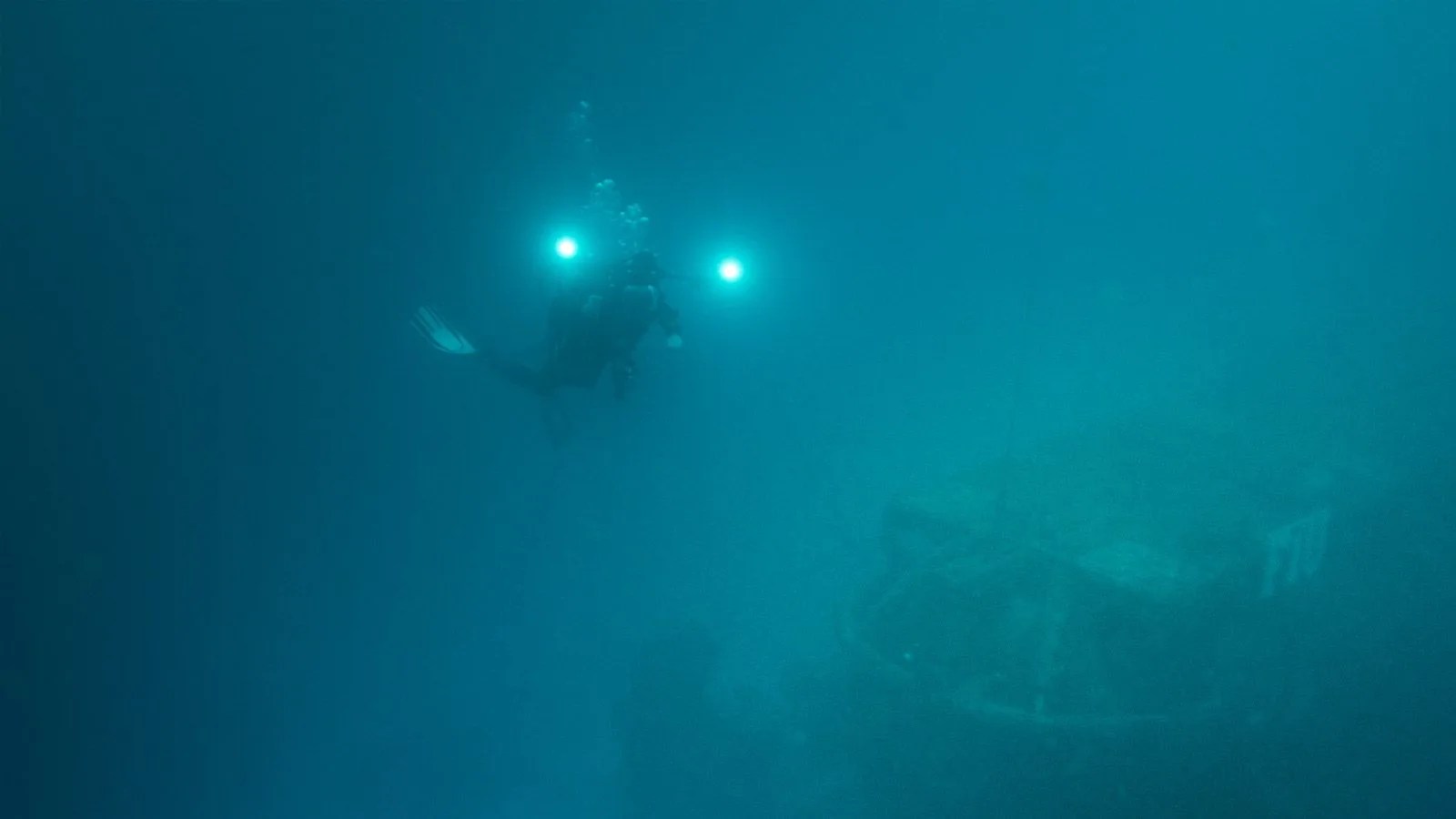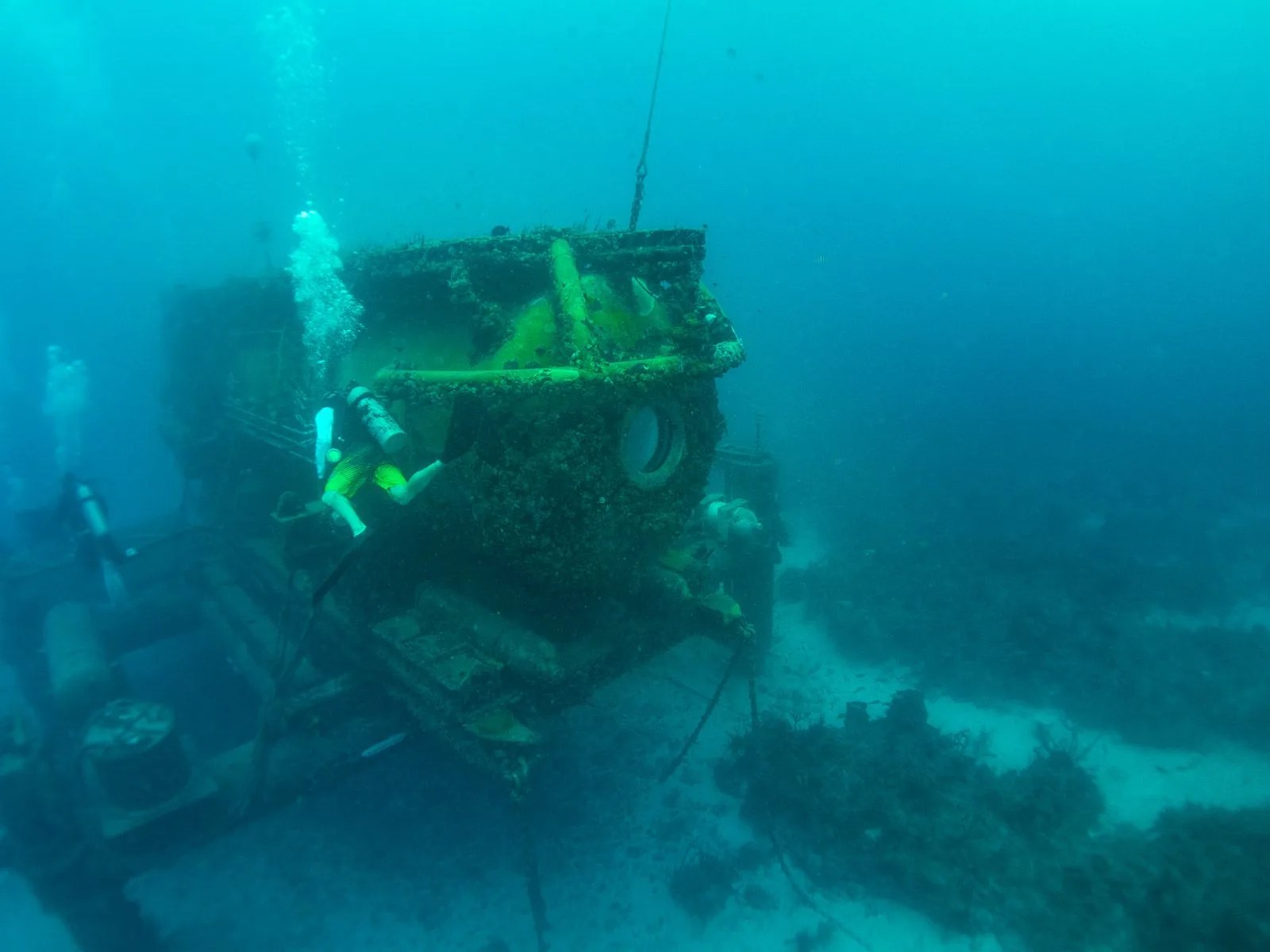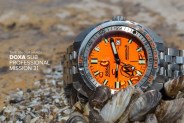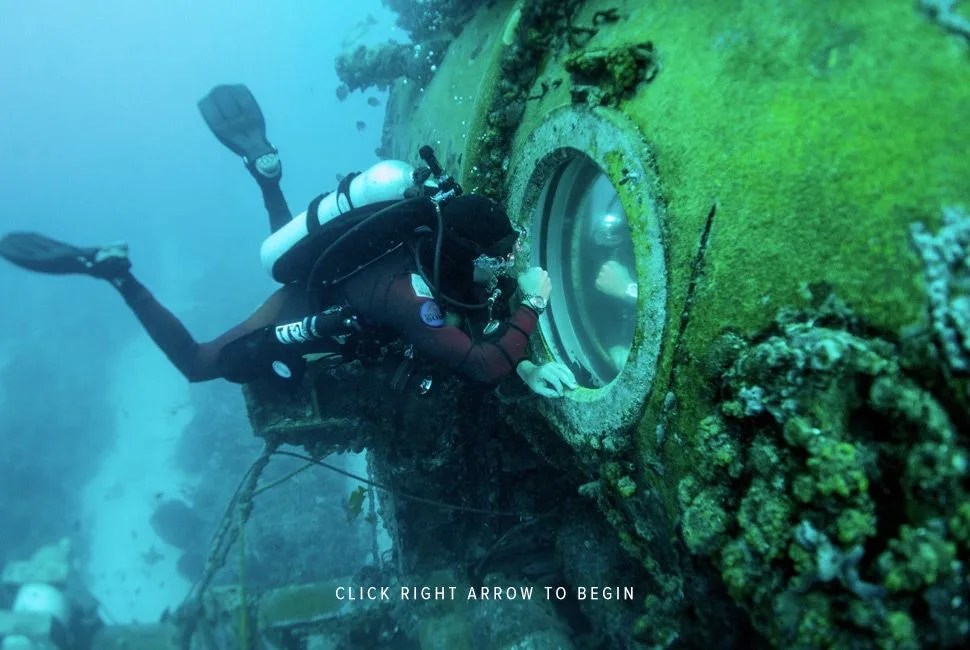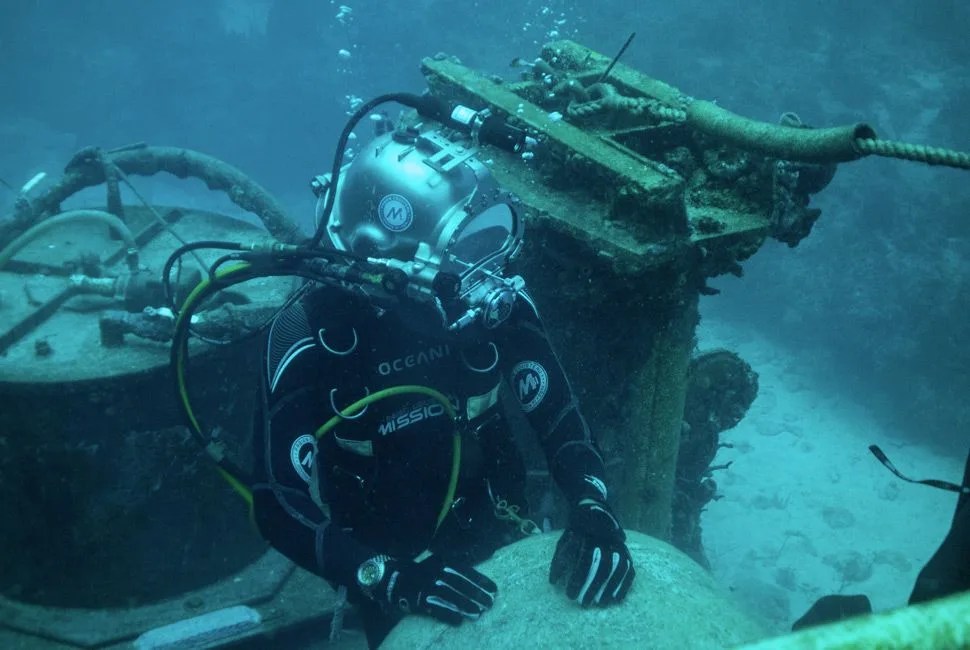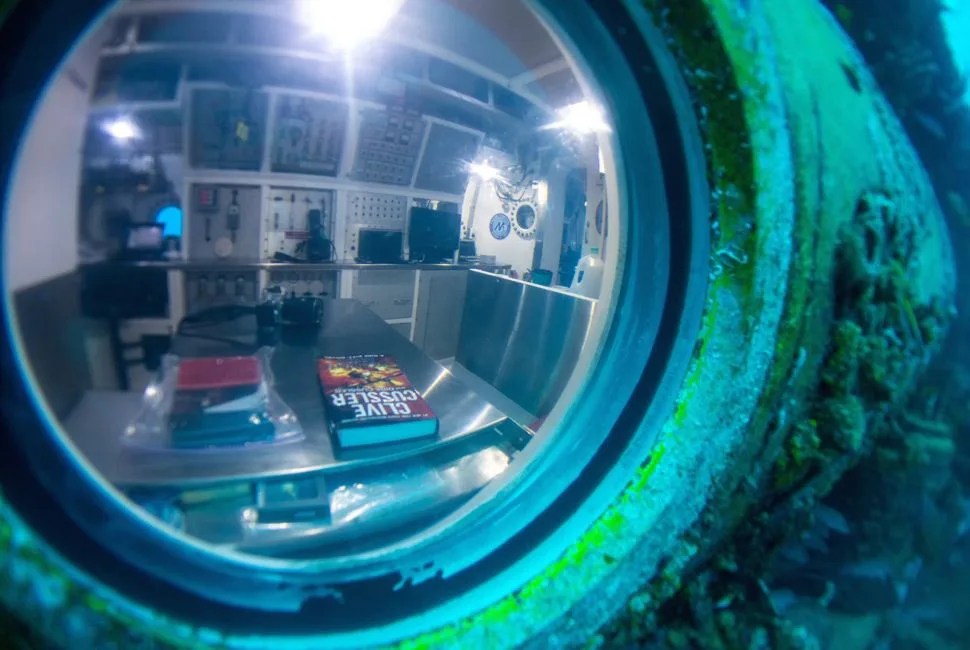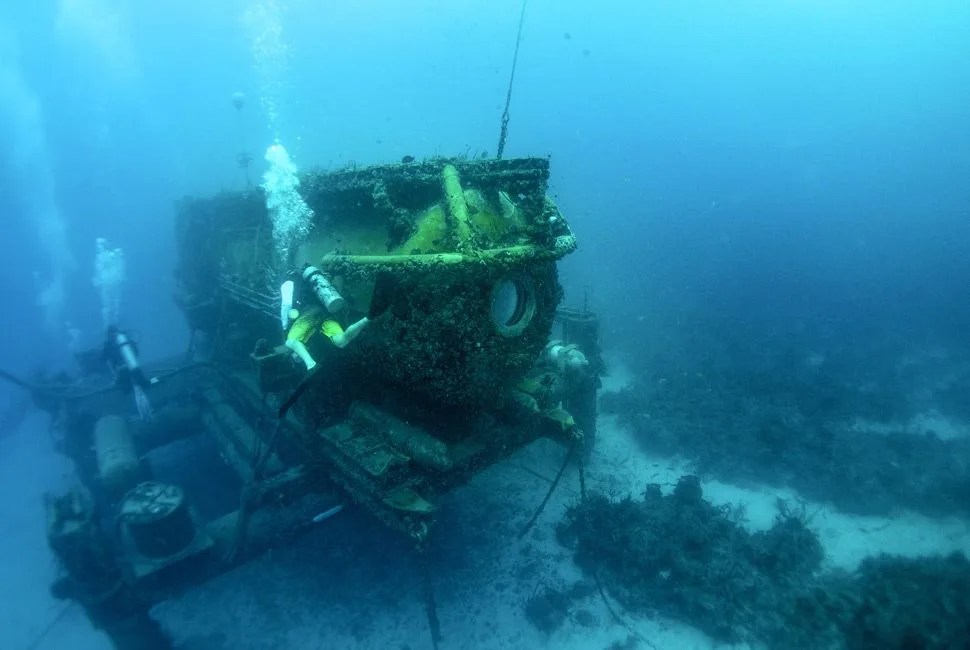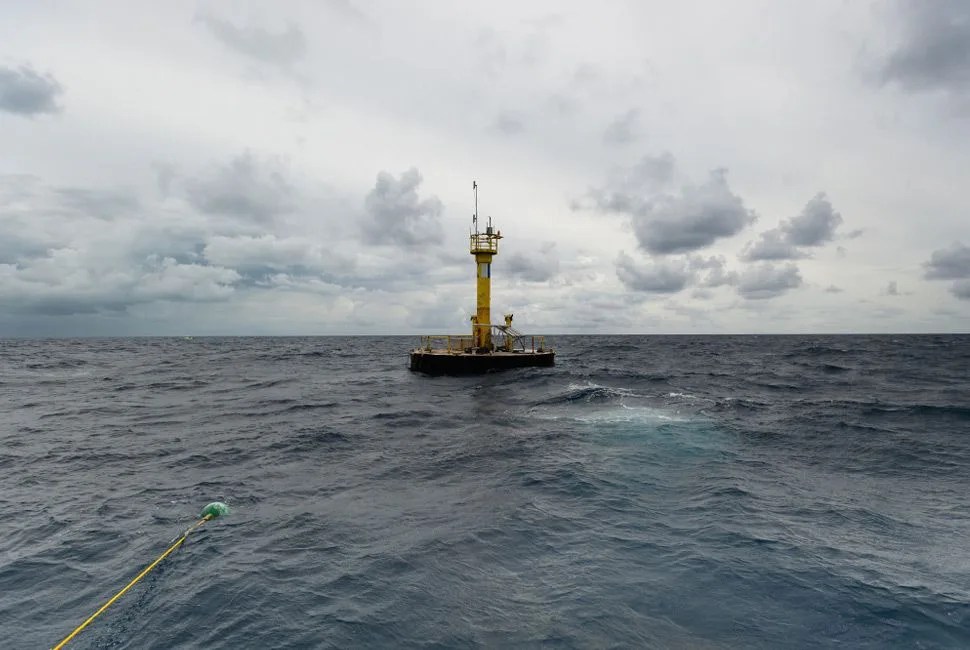The first full day of Mission 31 dawned stormy, and it was with some trepidation and a hastily chewed Bonine tablet that I boarded the boat at Reef Base in Islamorada to motor out to Aquarius. The wind and seas were at the limit of what the Mission 31 officials deemed safe diving conditions, but by the time we reached the underwater habitat’s Life Support Buoy (LSB), the waves had calmed enough to let me gear up and slip into the water. Once under the surface, the churning swells were replaced by calm and I descended to Aquarius, which was visible from above, the lights from its windows appearing like those of a cabin in the woods. As I approached, I could see schools of colorful reef fish picking at the coral that coated the habitat and, further down, several six-foot-long tarpon hanging in the shadows. A lone aquanaut was out walking on the seafloor, as if on the Moon, his helmet tethered to the habitat by a length of precious umbilical hoses.
I had been warned to keep my depth above 50 feet to maximize bottom time, and as I slipped under the “porch” of Aquarius, I saw my computer read 48 feet. I popped up inside the moon pool, removed my regulator and mask and took a breath of the pressurized air inside. “Welcome to Aquarius”, Fabien Cousteau said with a smile as he stood above me in the wet room.
Last time we caught up with Cousteau, he was preparing for Mission 31, his epic monthlong stay at Aquarius, the world’s only underwater research lab. After a June 1 splashdown, he’s over two weeks into his stay and all seems to be going as planned, other than an air conditioning hiccup that left Cousteau and his aquanauts sweltering in their school bus-sized home under the sea for a night or two.
I had less than an hour to spend inside the habitat. Cousteau led a hasty tour of his temporary home, out of the wet room, through the galley, past a panel of switches and gauges and intothe bunkroom. He pointed out emergency oxygen maks and the emergency escape hatch, driving home the point that this was no cabin in the woods. The constant ear-popping from the pressurized air and the unnerving rocking of the structure as the swell-tossed LSB umbilical tugged us from above were other reminders.
In the past fortnight, Aquarius has played host to a variety of guests, from actors, authors and news reporters to Fabien’s own father, Jean-Michel Cousteau, and another famous aquanaut, Sylvia Earle. The habitat’s aquanauts have celebrated World Ocean Day; they donned red caps to pay tribute to Fabien’s grandfather, Jacques-Yves Cousteau, on what would have been his 104th birthday on June 11. Earlier this week, Cousteau chatted with Richard Branson via Skype while two aquanauts and a cameraman decompressed and swapped places with their alternates for the remainder of the mission.
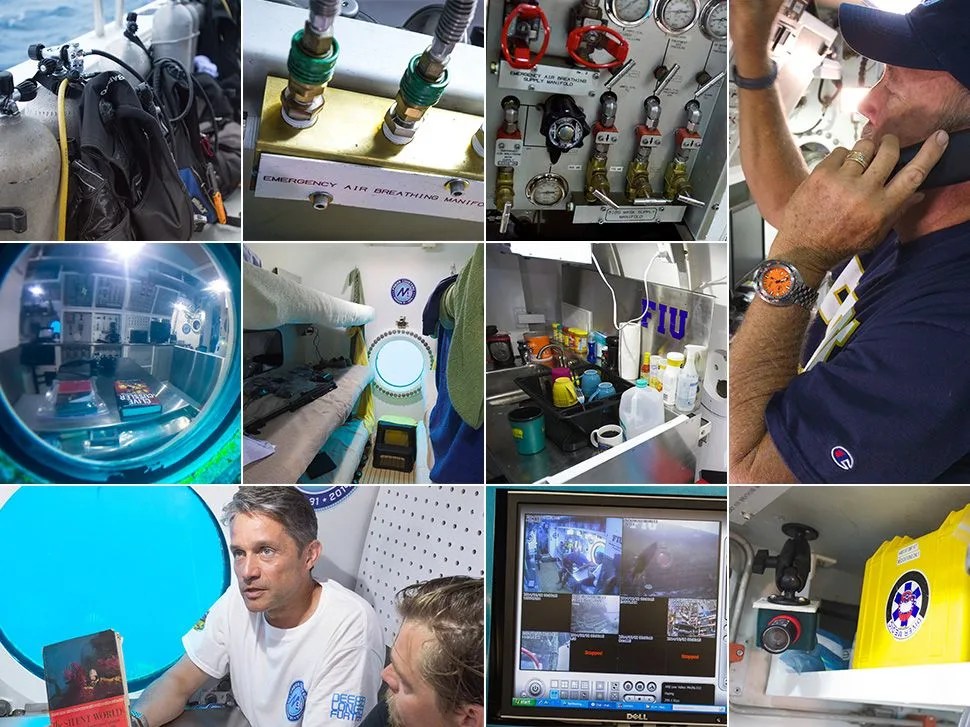
In between all the hospitality, the Mission 31 team has been busy studying coral growth, ocean acidification and predator/prey behavior using a variety of groundbreaking technologies such as wearable sonar devices, infrared slow-motion cameras, and small AUVs (Autonomous Underwater Vehicles) that dip into a coral polyp like a hummingbird to take samples. Cousteau has been conducting interviews via Skype with news agencies and classrooms all over the world, and the aquanauts’ every move is being followed by a 24/7 webcam mounted inside the living quarters. Hours of footage are being recorded using RED Epic and RED Dragon high-resolution cameras for a future documentary to ensure that Mission 31’s legacy lives well beyond its 31-day duration.
Aquarius may be state-of-the-art and filled with creature comforts like wireless internet and a microwave, but as the air conditioning failure showed, it’s not always smooth sailing 65 feet below the surface of the ocean. The habitat is eight miles offshore and entirely sustained by the unmanned Life Support Buoy (LSB) that is tethered above the habitat. The LSB’s diesel-powered compressors run constantly to provide Aquarius’s fresh air and the pressure that keeps the sea from flooding in through the habitat’s open moon pool. The LSB also holds electrical generators, solar arrays and satellite dishes, as well as the freshwater tanks that provide drinking water to the aquanauts. Both the habitat and its Life Support Buoy are built to withstand a hurricane; if the LSB fails or becomes detached, the habitat can be sealed off and become self-sustaining for a few days until help can arrive. That’s important: once saturated with compressed nitrogen, the aquanauts cannot come to the surface until they’ve decompressed for two days.
6 photos
Aquarius’s logistics are all overseen by Florida International University (FIU), which monitors the LSB, Aquarius and its inhabitants 24/7 from its Reef Base in Islamorada, Florida. Reef Base is run with the military precision and discipline of Mission Control. A Watch Desk is manned by a rotating staff that monitors multiple cameras around the habitat as well as data feeds for air quality, oxygen and CO2 percentages, heat, humidity, weather and a host of other minutiae required to keep six people alive below the sea. The similarity to a space mission is not coincidental. The conditions under the ocean are oddly parallel to those in outer space; indeed, Aquarius has often been used by NASA for training astronauts. The walls of Reef Base are covered with signed crew photos of various shuttle and space
station crews, thanking the FIU team for their help. There is a hierarchy of support staff on duty and at the ready should anything go wrong, from divers to boat captains. None are allowed to drink alcohol for the duration of an Aquarius mission and must always be within 10 minutes of the Reef Base while on call, should they be required to fire up a boat and speed out to Aquarius. In addition to the FIU staff that runs Aquarius, the U.S. Navy also provides divers to aid in shuttling supplies to and from the habitat and to help with checks on the LSB. Despite the jovial mood and made-for-media atmosphere around Mission 31, visiting Aquarius and seeing the safety measures in place drove home the point that there are very real risks in what these people are doing.
After finishing my short tour and making some small talk with the aquanauts, it was time to leave. I had 15 minutes until I’d owe a decompression debt, something I wasn’t prepared to pay: Reef Base had enough to worry about keeping the aquanauts alive, much less a visiting journalist. I wriggled back into my wet dive gear and, with a final handshake, slipped back into the moon pool and out into the open ocean. The boat moored above was pitching in the six-foot seas and seemed an unwelcome place compared to the cozy house below. I gave one last look at Aquarius before turning for the surface.
The Gear of Mission 31

Nokia Lumia 1020 with Watershot Underwater Housing: The Lumia represents the first salvo in Nokia’s return to smartphone competition, bringing the Windows phone operating system to the table in a big way. But the piece de resistance of the Lumia 1020 is its camera, a 41-megapixel shooter with Zeiss optics and good low-light still and video capabilities.
The Lumia is mounted around the interior of Aquarius for video blogging and informal shooting, but the real breakthrough for the expedition is its use on dives. Watershot, a respected maker of underwater camera housings, built a custom housing for the Lumia 1020 that allows Cousteau and his divers to take the phone out on exploratory dives and shoot stills and video. Though the screen cover is not touch sensitive, the housing is built to provide easy access to the power, video and shutter buttons on the camera phone. A red lens filter helps correct color loss at depth. Learn More
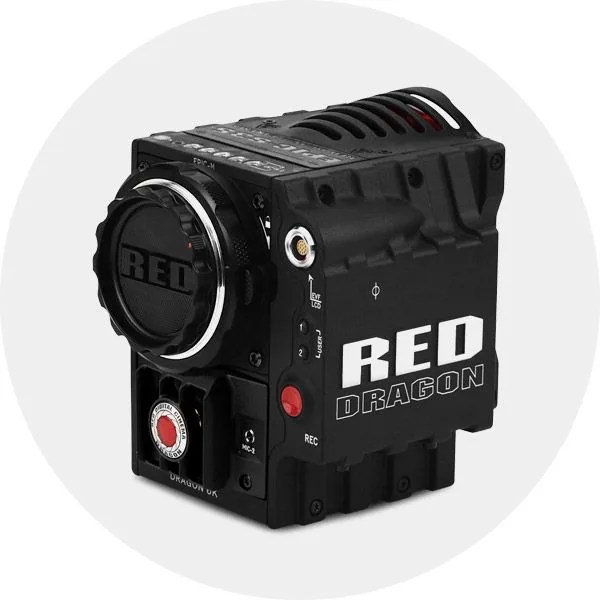
RED Epic Dragon Video Camera: Shooting at 6k resolution, RED cameras outperform just about every competitor available today — it’s no wonder Peter Jackson used RED cameras to film the Lord of the Rings movies. The Dragon shoots nine times more pixels than standard HD cameras and, with a capture speed of up to 100 frames per second, can output 19-megapixel still images in RAW format.
Mission 31’s director of photography Matt Ferraro and lead cameraman Kip Evans will be using the cameras (which cost $75,000 each) to collect hours of intimate footage of life under the sea in the Aquarius habitat, and will also take them on dives, safely encased in custom Gates and Nauticam housings. The resulting footage will be used to make a documentary film about Mission 31. Check those O-rings, guys! Learn More
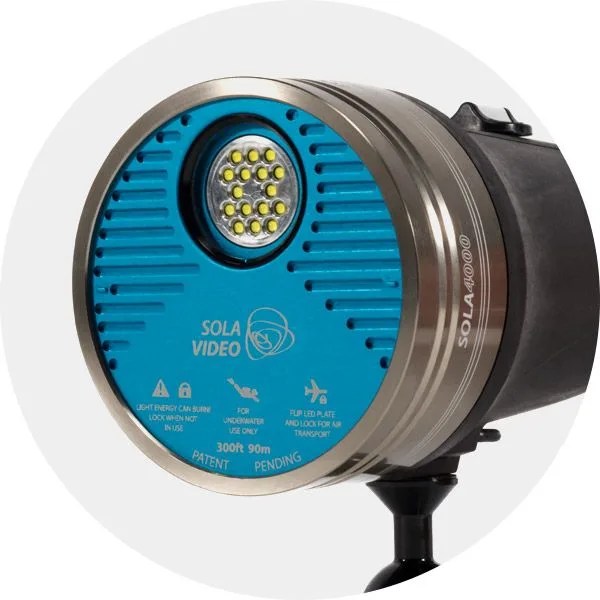
Light & Motion SOLA 4000 Video Lights: California-based Light & Motion is a leader in underwater video and dive lights, and we’ve been fans of their SOLA line for years. As its name suggests, the SOLA 4000 pumps out 4,000 lumens in a wide beam pattern. Add rechargeable batteries and intuitive controls and you’ve got the perfect dive light.
The Mission 31 divers are also using Light & Motion’s GoBe action cam lighting system (which allows strobe or flood lights to be mixed and matched depending on what video goals are) and mounting tray to accompany forays into the deep with their Watershot-housed Nokia Lumias. Learn More
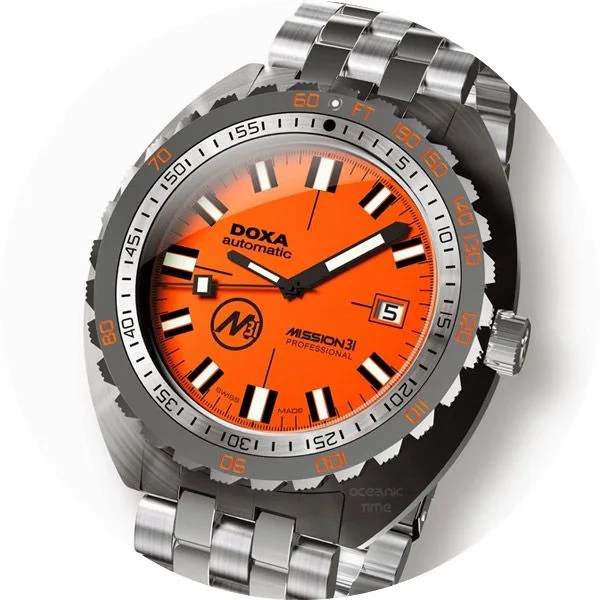
DOXA SUB Mission 31 Professional: DOXA returns to a Cousteau wrist four decades after Fabien’s grandfather favored a Sharkhunter for his undersea adventures. Of the 331 limited edition titanium Mission 31 versions built, 31 were delivered to Aquarius to be worn by Cousteau and crew during their mission.
These watches aren’t mere logoed baubles, though — Cousteau told us that there is no dive computer algorithm that will accomodate extended time inside a habitat, so he and his aquanauts will be relying on the timing bezel of their DOXAs to time their dives outside of Aquarius — a victory for analog in an otherwise hi-tech mission. The “mission-dived” watches will be sold to 31 lucky buyers after Mission 31 ends. Learn More
